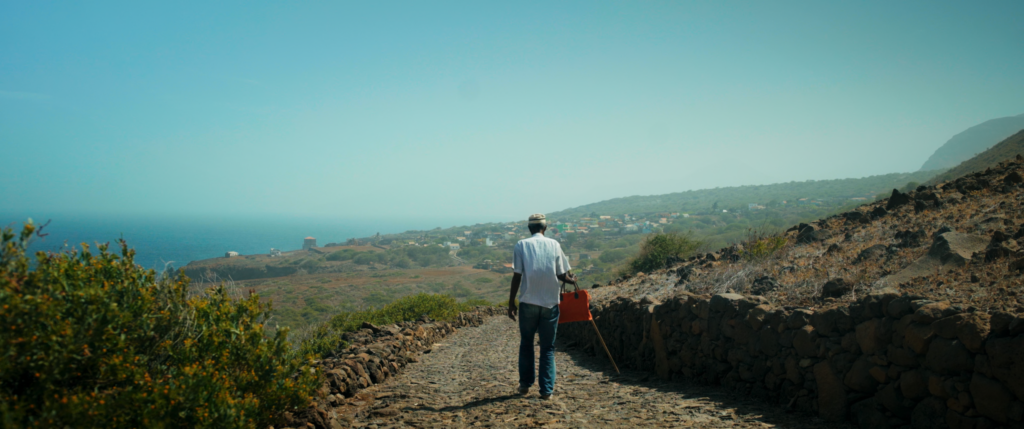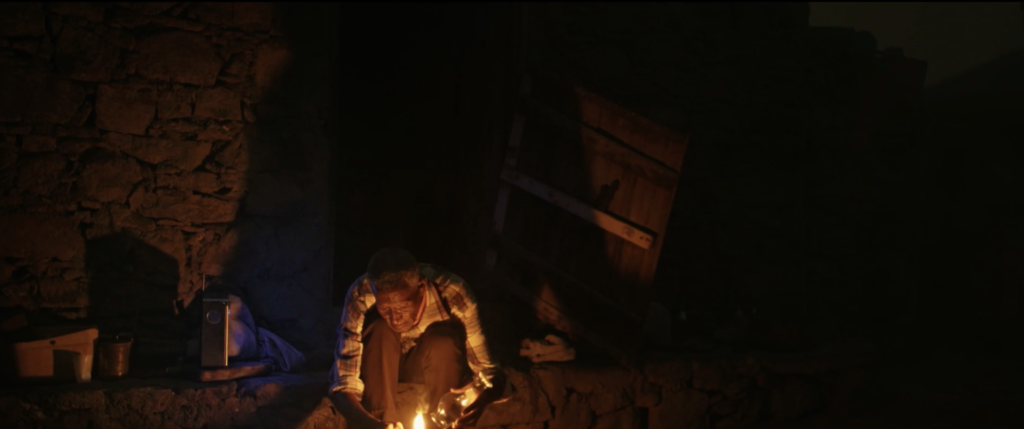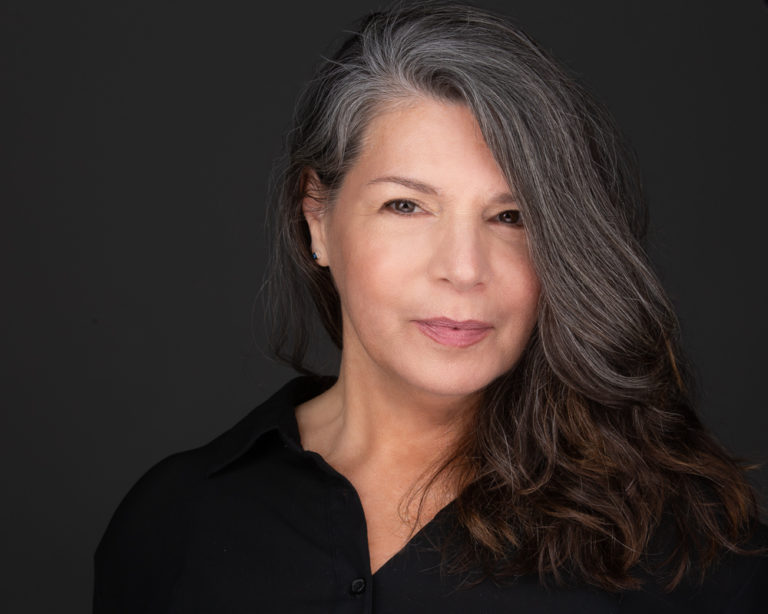
The path through many of life’s vital and intricate journeys rarely, if ever, presents as a straightforward trajectory. Only upon the chance to look back and reflect, can one see that, instead, some sort of spiral formation has revealed itself, a trail that circles both inwards and back out again in ways that create a sense of a unified vision. When Cape Verdean filmmaker Carlos Yuri Ceuninck and I reconnected for this conversation in early December, he happened to be on the island of São Vicente, the place where, in essence, his first feature film, Omi Nobu, lodged itself in his imagination. Yuri was living on São Vicente seven years ago, working for teleSUR, the South American news service based in Venezuela. He was partnered with the journalist Matilde Dias who was covering Cape Verde, making short news chronicles for the network.
At the time, the station wanted them to travel to all the islands of Cape Verde and the journalist mentioned the island of São Nicolau, a place Yuri knew about but to which he’d never been. The ten islands that make up Cape Verde are relatively close in distance, but somehow isolated because of the difficulties that exist in traveling between them. The journalist wanted to investigate the “ghost towns” on this rather big island and mentioned that there was one village in particular called Ribeira Funda where only one man still lived – an old man in his 70s who had been there all alone for more than forty years. Yuri “saw a film – right away, I saw it.” But he never made it there at the time since he had quit working for the program. However, the journalist went with a DoP called Arilson (Nenass) Almeida, the man who has lensed all of Yuri’s films, including Omi Nobu, Cape Verdean Creole for “the new man”.
Quirino Rodrigues had lived his whole life in Ribeira Funda, a place, that after a terrible tragedy, was deserted by its population. In 1983, a man was killed in his home by a massive rock that broke loose from the mountains following heavy rainfall that left a trail of destruction – and fear. The residents of the village felt such a deep unease after this that they abandoned their homes and moved to other places on the island. In a deep valley between the sea and those majestic mountains, Quirino spent his days alone with just a chicken for company (and a steady supply of eggs), and a transistor radio, his only connection to the rest of the world. By the time Yuri finally met Quirino, the “Superman” he had envisioned in his mind’s eye was a frail and sickly man on the cusp of realizing that he would need to finally leave his home and join his sister in a nearby town.
I had the privilege of mentoring Yuri for close to a year in 2021 – 2022 during the final production and post-production phases of Omi Nobu, in the midst of the Covid pandemic. Connecting Stories is a program made with support from The British Council, run through the Scottish Documentary Institute in Edinburgh, Scotland. The scheme is for filmmakers from Africa, Asia and the Middle East working on their first or second feature films. Each chosen maker is provided with a small production grant, online seminars, and dedicated and sustained mentorship to help support their production journey. Yuri had received the World Cinema Fund and other major development grants, but it was a very long and lonely road, nonetheless.
This past year, the film was the very first Cape Verdean film in the festival’s history to appear in the documentary competition at FESPACO in Burkina Faso, winning the grand prize there. It went on to play in competition at MONSTRA in São Paulo, as well as in the Luminous strand at this year’s IDFA in Amsterdam. It was there where Yuri and I met in person for the very first time for a real-life embrace, and to share the experience of a sold-out premiere screening of Omi Nobu in one of the jewel box cinemas at the grand Tuschinski movie theater.

Pamela Cohn (PC): This man called Quirino, or even the idea of him, captivated you many, many years ago now, way before you ever met him.
Carlos Yuri Ceuninck (CYC): Yes, this story, after first hearing of it, stayed with me for years. I was envisioning this film already while in fact I’d never been to Ribeira Funda, nor met Quirino. I had moved to Praia, the capital of Cape Verde, where I live now, after learning about him, but the idea never left me. The national TV station also did a very short piece and that’s when I saw the place itself. However, I couldn’t really take in the scope of it in this brief TV profile. In the meantime, I made my first short feature documentary, The Master’s Plan, that we made in the capital city.
PC: Tell me a bit about the contemporary cinema landscape in Cape Verde. You did realize some robust international support for The Master’s Plan but there was a steep learning curve.
CYC: The beginning of the desire to tell the story of Quirino did definitely move in tandem with my education about how to get a film financed and made. I studied cinema in Cuba at the International School of Film and TV from 2003 to 2006. I remember when I arrived in Cuba, I went straight to our embassy there to present myself and let them know I was there. The ambassador at the time received me and just assumed I was another medical student. There’s a history of Cape Verdeans training as doctors in Cuba. I told him that I was there to study cinema. He was really intrigued and honestly, so was I because, back then, I didn’t really fully realize why I was pursuing this path. It was intuitive in a way. The passion was there but the process came later. I wanted to bring something back to my country. Doctors we had, but I only really knew one filmmaker at the time who had studied in the States.
When I did come back, it was a shock. I had spent many years living outside the country – in the US, in Cuba, Europe. I returned with great enthusiasm in 2006. Unfortunately, that coincided with what I could call our “dark period” in terms of cinema. Only one movie theater had managed to stay open. There’s a debate about whether or not Cape Verde has a culture of cinema but when I was young, that was part of my generation’s life, to go to the cinema to see the Spaghetti Westerns, all the Bollywood films. São Vicente, where I am right now, had a cinema culture and now there are no more cinemas at all here. So, no one could propose anything to me when I came back.
After a year, I left again after having sold my camera and went to Belgium. [Yuri is half-Belgian on his father’s side]. Finally, in 2016, I came back and started to work for the television station in Praia and started to figure out a process, determined to survive, knowing that the only way for me to make films was to look for outside support. But I didn’t even know where to look. I saw a lot of funding opportunities on the Internet, but how to apply for them? I talked to Nenass, the DoP I’ve always worked with, and told him, okay, we’re going to make this film with money. [laughter] That had always been our goal, to make films this way, but for us, this was a brand-new concept, to look for funding outside Cape Verde in order to make a film here.
Finally, we were successful in receiving development money from the Hot Docs-Blue Ice Docs Fund. They chose five African projects that year. Something big opened up, especially through the mentorships I was provided. It really opened up the whole process for me, including the experience of traveling to big markets like Durban (FilmMart) in South Africa and AfricaDoc in Senegal. The latter doesn’t exist anymore. I learned how to pitch. We learned about co-productions and formed one with some Belgian producers. We made The Master’s Plan in good conditions. That experience enabled us to think about telling the story of Quirino.

PC: When you did finally meet Quirino, what were your impressions? How did that change what you might have had in your mind all those years? Essentially, your main character was very close to “crossing over” and you play with that beautifully in the film, the fact of his ephemerality. For me, this resonates so much in what you’re telling me about your own isolation. He is the new man of your film just as you became a new filmmaker of Cape Verde. Once you did start shooting, you were going back and forth into Quirino’s singular world and then back out again into the international landscape in order to sustain the project.
CYC: After a very long, complicated post-production, we finally finished The Master’s Plan in 2020. That film and Omi Nobu enabled me to finally find my language. I know this because of the way I’m approaching this 10-minute film I’m doing now for Al Jazeera. I was telling my wife and producing partner, Natasha [Craveiro], how I was going to make this short film. It’s a portrait of the kids who dive under the sea to collect iron. They then sell it on the shore and with that money go buy fish in the market. As I was describing the way I wanted to make this to Natasha, she said: but that’s Omi Nobu. My cinematic vision is clear for me. I’m not trying to make the same film, but she said that because she felt the same spirit for the piece I’m doing for “Africa Direct”, this series that Al Jazeera makes with executive producer, Steven Markovitz. Steven was the head of the jury at this year’s FESPACO, the one that awarded Omi Nobu a prize, so he already knew how I was going to make this one. That kind of trust on the part of a producer is huge for me – because he knows my language.
In terms of making Omi Nobu, you have to understand that I had “dreamt” about this film for so long, way before ever setting foot on the island where Quirino was living. My story was almost about a Superman, the total master of his surroundings who could survive all on his own. We made a self-funded trip to the island because I knew I needed to create a visual to take out into the world to find financing. When I finally went to Ribeira Funda, I was so shocked to, in fact, see a very weak man. The first scene in the film of him coming out of the house was one of the first images we shot of him. How is he surviving in this state? We had arrived at exactly the moment when he was realizing that he couldn’t live this way anymore. If we had made it there three years earlier, it would have been a completely different film. I had to accept this reality that this period for him was a big transition – we could all feel it.
We realized support from Ouaga Film Lab, and first financing from Le Fonds Jeune Création Francophone: JCF. This was before we had the title in Creole. It was just called The New Man, a way to suggest, in a way, the new man of the future, something that’s coming. I came upon this concept in so many places during my research – the idea of a better man. This exists in almost every religion or social movement.

PC: It’s difficult to make cinematic pieces about essentially what’s missing – not ghost stories, per se, but ghostly presences in landscapes, what used to be. Quirino’s surroundings, the island and the place of Ribeira Funda are distinct characters in Omi Nobu. The awesome scale of the place poetically sets off his isolation, the smallness of one man’s existence, which gives it a mythic quality, in fact.
CYC: You’re allowing me a place now, for the first time really, to reflect on this. I never saw Quirino as a ghost. He was very much in harmony with his environment, so much so that oftentimes he would completely blend into it, into the rocks themselves, like a chameleon. Between him and the place, there was this total symbiosis; he was just another element like the rocks and the sea. But one day, my crew and I were gathered around the computer watching footage we’d shot with Quirino once he’d gone to live in the village with his sister. It was David Medina, the sound man, who mentioned that it was then that Quirino felt like a ghost, when he was among other people. When he was alone, we never saw him like that – only when he was with others.
PC: There are many shots of Quirino looking directly into the camera throughout the film – when he’s alone and when he’s amongst other people – and that gesture, too, makes him present. Because of his isolation, this becomes such a direct and frank communication, one with you, but also with us, the spectators. It really solidified his presence for me.
CYC: I did notice that he always looked into the lens, which is not something I necessarily wanted him to do or asked him to do. This became a discussion in the edit, a very challenging edit, in fact – how to put this story together because Quirino had passed away during the making of it. So here, we accepted his constant looking into the camera and instead of trying to avoid it, it became intentional. It opened a door to him without a sense of trying to manipulate something, created an opportunity to open a dialogue with a man who doesn’t communicate with a lot of words or talks directly to us in the film.

PC: What do you think could be possible now and in the future for a cinema landscape on Cape Verde? Not just films coming out of the country by Cape Verdeans and other makers who have made work there but aren’t of that place. Do you envision a re-emergence of the kind of presence of cinema that was there when you were growing up?
CYC: That’s a big question. Omi Nobu is an important film – for me, certainly, but in general. We don’t really have the critical lens through which to look at the work we’re making now; that’s also for the future, hopefully. There is a canon of films made in the 1950s during the colonial period up until the eighties and nineties that tell stories from here. But only in the past decade or so have there been more films made by us, the people who are from here, who live here.
This film was a film I dreamt, and now that it’s made, I’m waking up to that realization too. It is something that lives outside of me finally. I see clearly the difficulties that still exist, the need to create some kind of industry here. The Ministry of Culture did support the Cape Verdean premiere. All this creates a chance for me, for all of us, to reflect on what this means. Eight years on, now quite a few Cape Verdean projects travel to various international markets; a few have appeared at major festivals. You do expect big changes suddenly, so the reality of it feels bittersweet. The film came with a lot of things – prizes, exposure to various places – which brings in a lot of light, as well as the emergence of my language as a filmmaker, which I mentioned earlier.
But why do I make films? Only by making this film could I realize that the reason resides in the realm of my childhood memories. In the 80s, when I was between the ages of eight and twelve, we lived on a sparsely populated island called Boa Vista. It’s very touristic now. It doesn’t exist anymore, this place of my childhood. The island was a mini-Sahara with big sand dunes. I could go to the sea by myself to swim. I was free because everything was safe in that world. In those days, after dinner, my father would choose a film to play on the Betamax, stuff like Sergio Leone’s The Good, the Bad and the Ugly. I remember the music of Ennio Morricone. It was magical. When we watched films in our living room, my mother would open the front door so the neighbors could pass by and watch too. I make films in the desire of re-living these shared experiences. I know it’s idealistic because making this film isn’t really going to change things that much. But it’s the beginning of a longer journey. I’m grateful for it all.

Pamela Cohn is a Helsinki-based critic, writer, film & video curator, story structure consultant, and festival moderator. She’s the author of Lucid Dreaming: Conversations with 29 Filmmakers(OR Books, New York & London, 2020), and co-producer and host of The Lucid Dreaming Podcast: Conversations on Cinema, Art & Moving Image. http://www.pamelacohn.com/
